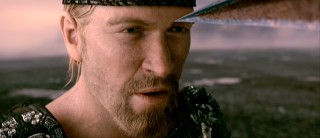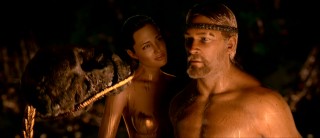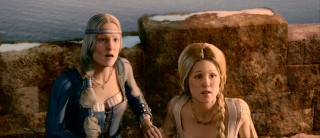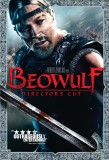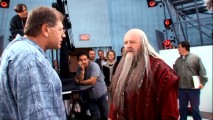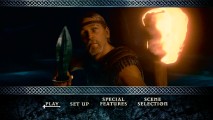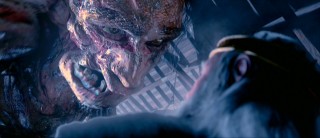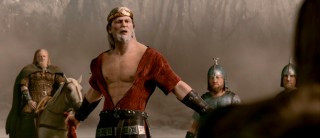Beowulf: Director's Cut DVD Review
 |
Beowulf
Theatrical Release: November 16, 2007 / Running Time: 115 Minutes (Theatrical Cut: ?) / Rating: Not Rated (Theatrical Cut: PG-13) Director: Robert Zemeckis Cast: Ray Winstone (Beowulf, Golden Man, Dragon), Anthony Hopkins (Hrothgar), John Malkovich (Unferth), Robin Wright Penn (Wealthow), Brendan Gleeson (Wiglaf), Crispin Glover (Grendel), Alison Lohman (Ursula), Angelina Jolie (Grendel's Mother), Charlotte Salt (Estrith), Greg Ellis (Garmund), Rik Young (Eofor), Sebastian Roche (Wulfgar), Leslie Zemeckis (Yrsa), Costas Mandylor (Hondshew), Dominic Keating (Cain) |
Buy Beowulf from Amazon.com: Director's Cut DVD • Theatrical Cut DVD • Director's Cut Blu-ray
Since the introduction of computer-generated imagery, filmmakers have constantly sought to evoke realism. After efforts successfully blended CGI with live action (notably in such works as Terminator 2: Judgment Day and Jurassic Park), Director Robert Zemeckis tried his hand at it in 2004 with The Polar Express, using the motion capture technology made famous by Peter Jackson on his Lord of the Rings trilogy. While the animation of Polar Express unsettled many viewers, it slowly but surely found financial success. This allowed Zemeckis and his production company ImageMovers to further explore the possibilities of motion capture, on the Oscar-nominated Monster House (2006). Zemeckis then turned to directing Beowulf, another motion capture film, which like Polar Express, would feature animation that at first glance could easily be mistaken for live-action.
Based on the epic poem, Beowulf opens in Denmark, 507 A.D., when King Hrothgar (Anthony Hopkins), Queen Wealthow (Robin Wright Penn), and their merrymaking subjects are terrorized by a deformed creature known as Grendel (Crispin Glover). Hrothgar requests help from anyone who dares to challenge Grendel, and an enthusiastic, glory-hungry warrior named Beowulf (Ray Winstone) steps up to the task. He quickly discovers, though, that Grendel is the least of anyone's worries. The creature's demonic mother (Angelina Jolie) resides in a cave outside the city and, as long as she lives, there is always the possibility of more offspring to wreak havoc on the kingdom. The tale follows our hero as he struggles with his own pride and vanity at the cost of those around him.
What helps set apart Beowulf from other period epics recently released is its tongue-in-cheek humor. While certainly first and foremost an action-drama, there's a sense of playfulness that keeps it from becoming too self-absorbed. Whether it's through innuendo or intentionally campy dialogue, Beowulf is not afraid to poke fun at itself while still believing in the story it has to tell. Many purists of the original poem will balk at the treatment found here, but the film is actually fairly clever in its adaptation. The source material does not lend itself very well to a straight cinematic interpretation, as events just happen in the original with little rhyme or reason. Zemeckis' film, specifically the screenplay by Neil Gaiman (Stardust) and Roger Avary (Pulp Fiction), takes the major points of the poem and weaves its own story to connect them all together. In the process, it makes our lead character more palatable than the perfect, aloof warrior from tradition.
What has been getting people's attention about Beowulf is its CG animation. While the results here are certainly a step up from Polar Express, they aren't a complete success. When downplayed, the animation can be breathtaking. Scenes of characters just speaking to each other feature far more nuances and details than one would expect. Scenery, fabrics, and hair are all outstandingly rendered. The problem stems from movement. When characters are running or engaging in combat, they come across very stiffly and unnaturally. What Zemeckis and his crew fail to understand is that what works in live-action doesn't always work in animation. Things need to be exaggerated for the animation medium, something classic Disney animators understood even with live-action reference footage at their disposal.
Another problem is in the designs of the humans. With an infinite number of options in their laps, it's baffling that the animators chose to render most of the characters identical to their live actor counterparts. This essentially makes the idea of a CG-animated film pointless. It's true this sort of production still seamlessly blends people, places, and creatures in a way that would be more difficult via live-action, and it enables the cinematography to more be free and creative. Even with those benefits in mind, though, the biggest plus from this medium is allowing actors to play characters they may not normally be able to play physically. This approach is used when transforming short, stout Ray Winstone into the physically ideal Beowulf, but many of the other actors are basically cloned. Not only does such an approach reek of marketing, but it makes the animation look even more rigid because it constantly reminds the viewer of the actual actor.
Animation problems aside, Beowulf is still a generally well-made film. Its script, performances, and technical attributes help overcome the awkwardness of some of the character animation. The action is rousing, the tone balances humor and drama well, and the story features deeper ideas than some recent entries in this genre. Note that the edition reviewed here is the director's cut. Differences between this and the theatrical version are quite minimal. The two action scenes of Grendel barging into the mead hall feature extra shots of violence that may or may not have garnered the film an "R" rating. The opening sequence also features a bit more promiscuity during the celebrations, though no nudity. VIDEO and AUDIO
Beowulf is presented in a 2.35:1 anamorphic widescreen transfer. Being a computer-generated film, the image quality is immaculate and appears to be taken directly from the digital source. The picture is regularly crisp, detailed, and free of digital artifacts. The film's usually warm color palette is faithfully and vividly reproduced. This reference quality transfer is the best the film can possibly look in standard definition.
The Dolby Digital 5.1 surround soundtrack is equally impressive. Surrounds are utilized well during the action set pieces and even occasionally during the more dialogue-driven scenes. The sound effects at times become startlingly loud, but this in tune with the intent of the sound designers. Speech is clear and not overpowered by the broad, sweeping musical score. The track as a whole envelopes the listener into the film's world very well.
BONUS FEATURES, MENUS and PACKAGING
A handful of supplements begin with "A Hero's Journey: The Making of Beowulf" (23:55). This candid featurette contains very few sit-down interviews and film clips. Instead, it's made up mostly of behind the scenes footage ranging from Ray Winstone's daily morning routines to Robert Zemeckis directing the dot-covered cast. Several shorter, more traditional featurettes follow that could've been edited into the above piece to form a single documentary.
"Beasts of Burden: Designing the Creatures of Beowulf" (6:56) examines the various fantastical beings in the story. The designers discuss the challenges faced in coming up with unique looks for the creatures, and they explain the symbolism behind some of the designs. Lots of information is covered in a short amount of time in this informative featurette.
Next comes "The Origins of Beowulf" (5:13). Here, the filmmakers discuss the source material and the obstacles faced trying to adapt it into a cinematic structure. Like the above piece, much is conveyed in a brief amount of time.
Unfortunately, "Creating the Ultimate Beowulf" (1:58) is by far the weakest of the supplements. The concept of taking the performance of a portly fellow like Ray Winstone and transferring it into the CG adonis of Beowulf is briefly talked about. While the topic intrigues, the runtime allows for little beyond praise for the work done in designing the lead.
The featurettes close with a return to quality in the brief but enlightening "The Art of Beowulf" (5:25). The film's various environments and their appearances are analyzed while concept artwork and miniature models are showcased.
Six deleted scenes (10:08) are featured in rough, unfinished animation. The scenes in question would've neither helped nor hindered the story very much, Finally, the theatrical trailer (1:56) is thankfully included along with previews for Iron Man, Shine a Light, and The Kite Runner.
An Easter egg can be found on the first bonus material page. Entitled "A Coffee Break with John Malkovich" (1:11), this clip shows the esteemed actor getting several cups of coffee and... drinking them. This is an odd and random thing to put on the disc, and one would've preferred the type of hidden bonuses found on Warner's The Polar Express, which compared live-action motion capture footage to the final film animation.
The main menu contains a montage of clips bordered by a steely gray design. The other menus are all silent and static, featuring promotional character images and the rocky surface of Grendel's mother's cave. As usual for Paramount DVD, there is no insert or colored disc art.
CLOSING THOUGHTS
Beowulf sets out to create a photo-realistic animated film, but it only partially succeeds. It does have more to offer, however, via its tight story and thrilling action sequences. The director's cut additions will probably go unnoticed by many who saw the film in theaters, but it's still presented with outstanding video and audio. Despite being brief, the bonus material reveals much about the production. Still, it's disappointing that Robert Zemeckis didn't contribute an audio commentary. Beowulf earns a recommendation to fans of action epics, though those looking for fidelity to the source material may want to rent it first.
Buy Beowulf from Amazon.com: Director's Cut DVD / Theatrical Cut DVD / Director's Cut Blu-ray
|
Related Reviews:
UltimateDisney.com | DVDizzy.com: New and Upcoming DVD & Blu-ray Schedule | DVD and Blu-ray Reviews | Upcoming Cover Art | Search This Site
Stardust • TMNT • Bram Stoker's Dracula • Shrek the Third • Sleeping Beauty • Renaissance
Directed by Robert Zemeckis: Who Framed Roger Rabbit • Forrest Gump (15th Anniversary Chocolate Box Giftset)
The Chronicles of Narnia: The Lion, The Witch and The Wardrobe - Four-Disc Extended Edition
Braveheart: Special Collector's Edition • King Arthur: Director's Cut • The Princess Bride: 20th Anniversary Edition
Dragonslayer • Pathfinder • The Village • The Aristocats: Special Edition • Ratatouille
New to DVD: COPS: 20th Anniversary Edition • It's the Easter Beagle, Charlie Brown: Remastered Deluxe Edition
